The Use of Animals in Psychological Research: Experiments and Theories
VerifiedAdded on 2021/04/21
|7
|2680
|84
Essay
AI Summary
This essay delves into the historical and influential use of animal experiments in the field of psychology. It examines several key experiments, including Pavlov's classical conditioning with dogs, Skinner's operant conditioning using the Skinner box with rats, Harlow's studies on infant-mother attachment using monkeys, and Seligman's learned helplessness experiments. These experiments provided valuable insights into various psychological processes, such as learning, behavior modification, and emotional development. The essay discusses the methodologies, findings, and implications of these experiments, highlighting how they contributed to our understanding of both animal and human psychology. Furthermore, it considers the ethical implications of using animals in research and the impact of these studies on the development of psychological theories. The essay provides a comprehensive overview of these landmark studies, illustrating their significance in shaping the field of psychology.
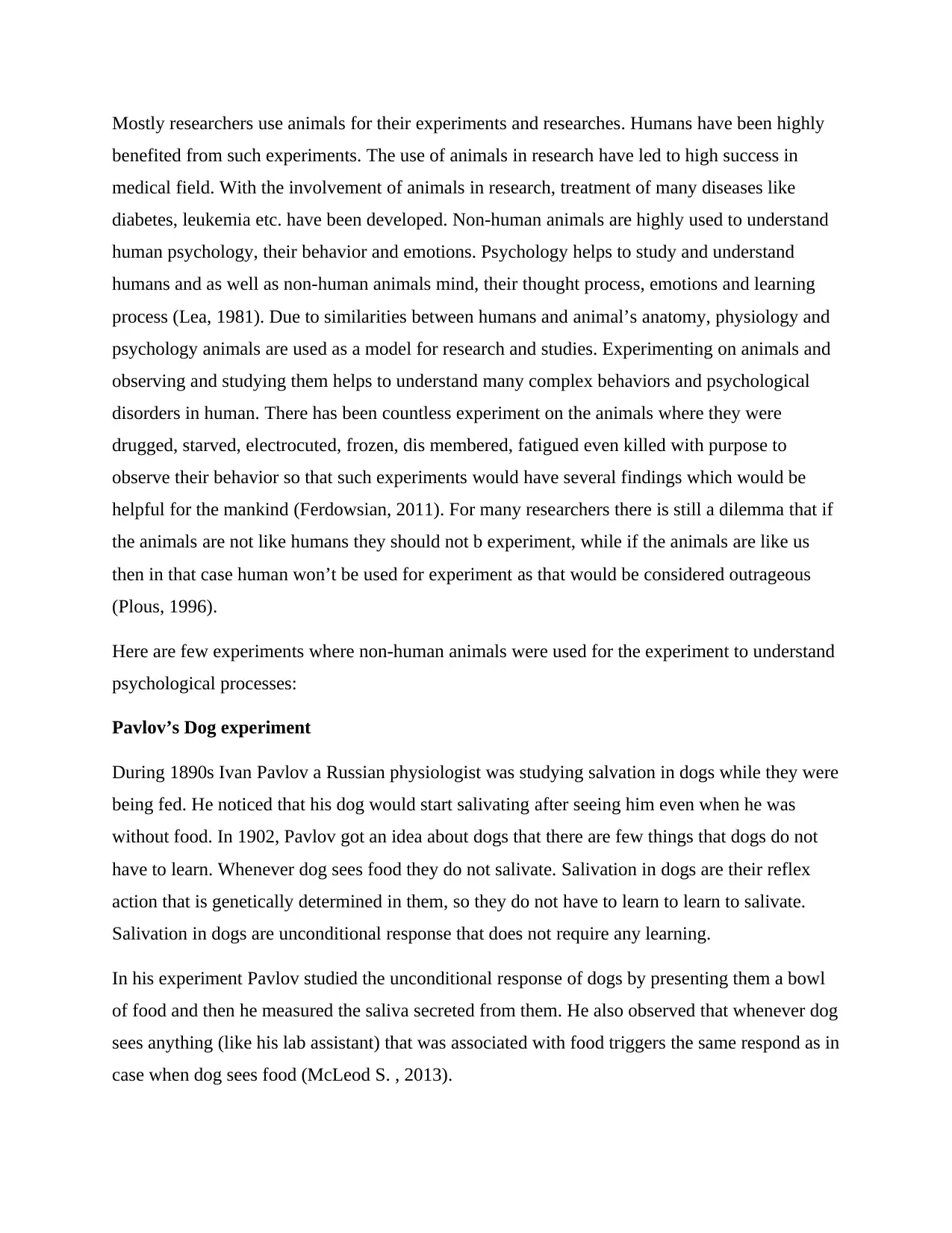
Mostly researchers use animals for their experiments and researches. Humans have been highly
benefited from such experiments. The use of animals in research have led to high success in
medical field. With the involvement of animals in research, treatment of many diseases like
diabetes, leukemia etc. have been developed. Non-human animals are highly used to understand
human psychology, their behavior and emotions. Psychology helps to study and understand
humans and as well as non-human animals mind, their thought process, emotions and learning
process (Lea, 1981). Due to similarities between humans and animal’s anatomy, physiology and
psychology animals are used as a model for research and studies. Experimenting on animals and
observing and studying them helps to understand many complex behaviors and psychological
disorders in human. There has been countless experiment on the animals where they were
drugged, starved, electrocuted, frozen, dis membered, fatigued even killed with purpose to
observe their behavior so that such experiments would have several findings which would be
helpful for the mankind (Ferdowsian, 2011). For many researchers there is still a dilemma that if
the animals are not like humans they should not b experiment, while if the animals are like us
then in that case human won’t be used for experiment as that would be considered outrageous
(Plous, 1996).
Here are few experiments where non-human animals were used for the experiment to understand
psychological processes:
Pavlov’s Dog experiment
During 1890s Ivan Pavlov a Russian physiologist was studying salvation in dogs while they were
being fed. He noticed that his dog would start salivating after seeing him even when he was
without food. In 1902, Pavlov got an idea about dogs that there are few things that dogs do not
have to learn. Whenever dog sees food they do not salivate. Salivation in dogs are their reflex
action that is genetically determined in them, so they do not have to learn to learn to salivate.
Salivation in dogs are unconditional response that does not require any learning.
In his experiment Pavlov studied the unconditional response of dogs by presenting them a bowl
of food and then he measured the saliva secreted from them. He also observed that whenever dog
sees anything (like his lab assistant) that was associated with food triggers the same respond as in
case when dog sees food (McLeod S. , 2013).
benefited from such experiments. The use of animals in research have led to high success in
medical field. With the involvement of animals in research, treatment of many diseases like
diabetes, leukemia etc. have been developed. Non-human animals are highly used to understand
human psychology, their behavior and emotions. Psychology helps to study and understand
humans and as well as non-human animals mind, their thought process, emotions and learning
process (Lea, 1981). Due to similarities between humans and animal’s anatomy, physiology and
psychology animals are used as a model for research and studies. Experimenting on animals and
observing and studying them helps to understand many complex behaviors and psychological
disorders in human. There has been countless experiment on the animals where they were
drugged, starved, electrocuted, frozen, dis membered, fatigued even killed with purpose to
observe their behavior so that such experiments would have several findings which would be
helpful for the mankind (Ferdowsian, 2011). For many researchers there is still a dilemma that if
the animals are not like humans they should not b experiment, while if the animals are like us
then in that case human won’t be used for experiment as that would be considered outrageous
(Plous, 1996).
Here are few experiments where non-human animals were used for the experiment to understand
psychological processes:
Pavlov’s Dog experiment
During 1890s Ivan Pavlov a Russian physiologist was studying salvation in dogs while they were
being fed. He noticed that his dog would start salivating after seeing him even when he was
without food. In 1902, Pavlov got an idea about dogs that there are few things that dogs do not
have to learn. Whenever dog sees food they do not salivate. Salivation in dogs are their reflex
action that is genetically determined in them, so they do not have to learn to learn to salivate.
Salivation in dogs are unconditional response that does not require any learning.
In his experiment Pavlov studied the unconditional response of dogs by presenting them a bowl
of food and then he measured the saliva secreted from them. He also observed that whenever dog
sees anything (like his lab assistant) that was associated with food triggers the same respond as in
case when dog sees food (McLeod S. , 2013).
Paraphrase This Document
Need a fresh take? Get an instant paraphrase of this document with our AI Paraphraser
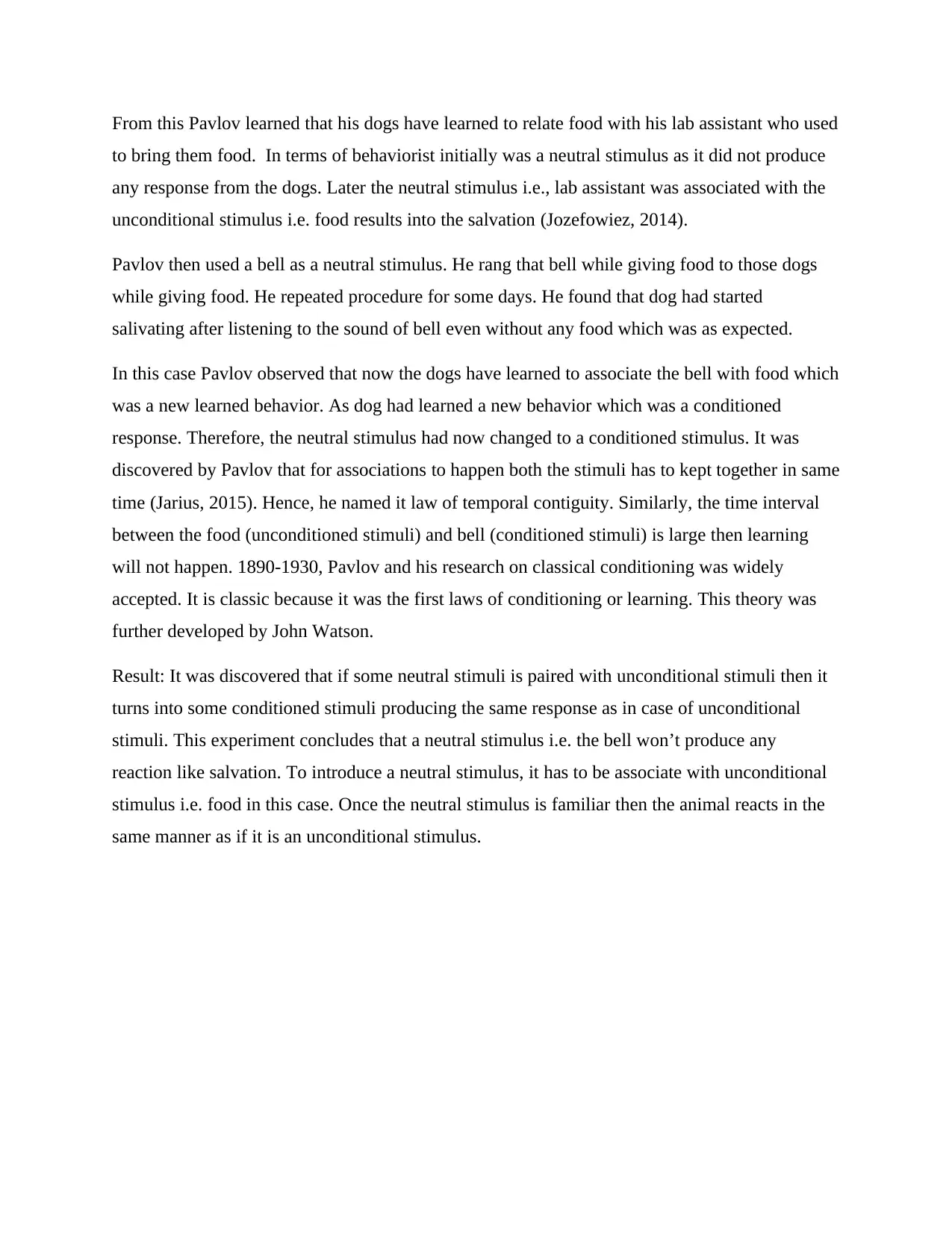
From this Pavlov learned that his dogs have learned to relate food with his lab assistant who used
to bring them food. In terms of behaviorist initially was a neutral stimulus as it did not produce
any response from the dogs. Later the neutral stimulus i.e., lab assistant was associated with the
unconditional stimulus i.e. food results into the salvation (Jozefowiez, 2014).
Pavlov then used a bell as a neutral stimulus. He rang that bell while giving food to those dogs
while giving food. He repeated procedure for some days. He found that dog had started
salivating after listening to the sound of bell even without any food which was as expected.
In this case Pavlov observed that now the dogs have learned to associate the bell with food which
was a new learned behavior. As dog had learned a new behavior which was a conditioned
response. Therefore, the neutral stimulus had now changed to a conditioned stimulus. It was
discovered by Pavlov that for associations to happen both the stimuli has to kept together in same
time (Jarius, 2015). Hence, he named it law of temporal contiguity. Similarly, the time interval
between the food (unconditioned stimuli) and bell (conditioned stimuli) is large then learning
will not happen. 1890-1930, Pavlov and his research on classical conditioning was widely
accepted. It is classic because it was the first laws of conditioning or learning. This theory was
further developed by John Watson.
Result: It was discovered that if some neutral stimuli is paired with unconditional stimuli then it
turns into some conditioned stimuli producing the same response as in case of unconditional
stimuli. This experiment concludes that a neutral stimulus i.e. the bell won’t produce any
reaction like salvation. To introduce a neutral stimulus, it has to be associate with unconditional
stimulus i.e. food in this case. Once the neutral stimulus is familiar then the animal reacts in the
same manner as if it is an unconditional stimulus.
to bring them food. In terms of behaviorist initially was a neutral stimulus as it did not produce
any response from the dogs. Later the neutral stimulus i.e., lab assistant was associated with the
unconditional stimulus i.e. food results into the salvation (Jozefowiez, 2014).
Pavlov then used a bell as a neutral stimulus. He rang that bell while giving food to those dogs
while giving food. He repeated procedure for some days. He found that dog had started
salivating after listening to the sound of bell even without any food which was as expected.
In this case Pavlov observed that now the dogs have learned to associate the bell with food which
was a new learned behavior. As dog had learned a new behavior which was a conditioned
response. Therefore, the neutral stimulus had now changed to a conditioned stimulus. It was
discovered by Pavlov that for associations to happen both the stimuli has to kept together in same
time (Jarius, 2015). Hence, he named it law of temporal contiguity. Similarly, the time interval
between the food (unconditioned stimuli) and bell (conditioned stimuli) is large then learning
will not happen. 1890-1930, Pavlov and his research on classical conditioning was widely
accepted. It is classic because it was the first laws of conditioning or learning. This theory was
further developed by John Watson.
Result: It was discovered that if some neutral stimuli is paired with unconditional stimuli then it
turns into some conditioned stimuli producing the same response as in case of unconditional
stimuli. This experiment concludes that a neutral stimulus i.e. the bell won’t produce any
reaction like salvation. To introduce a neutral stimulus, it has to be associate with unconditional
stimulus i.e. food in this case. Once the neutral stimulus is familiar then the animal reacts in the
same manner as if it is an unconditional stimulus.
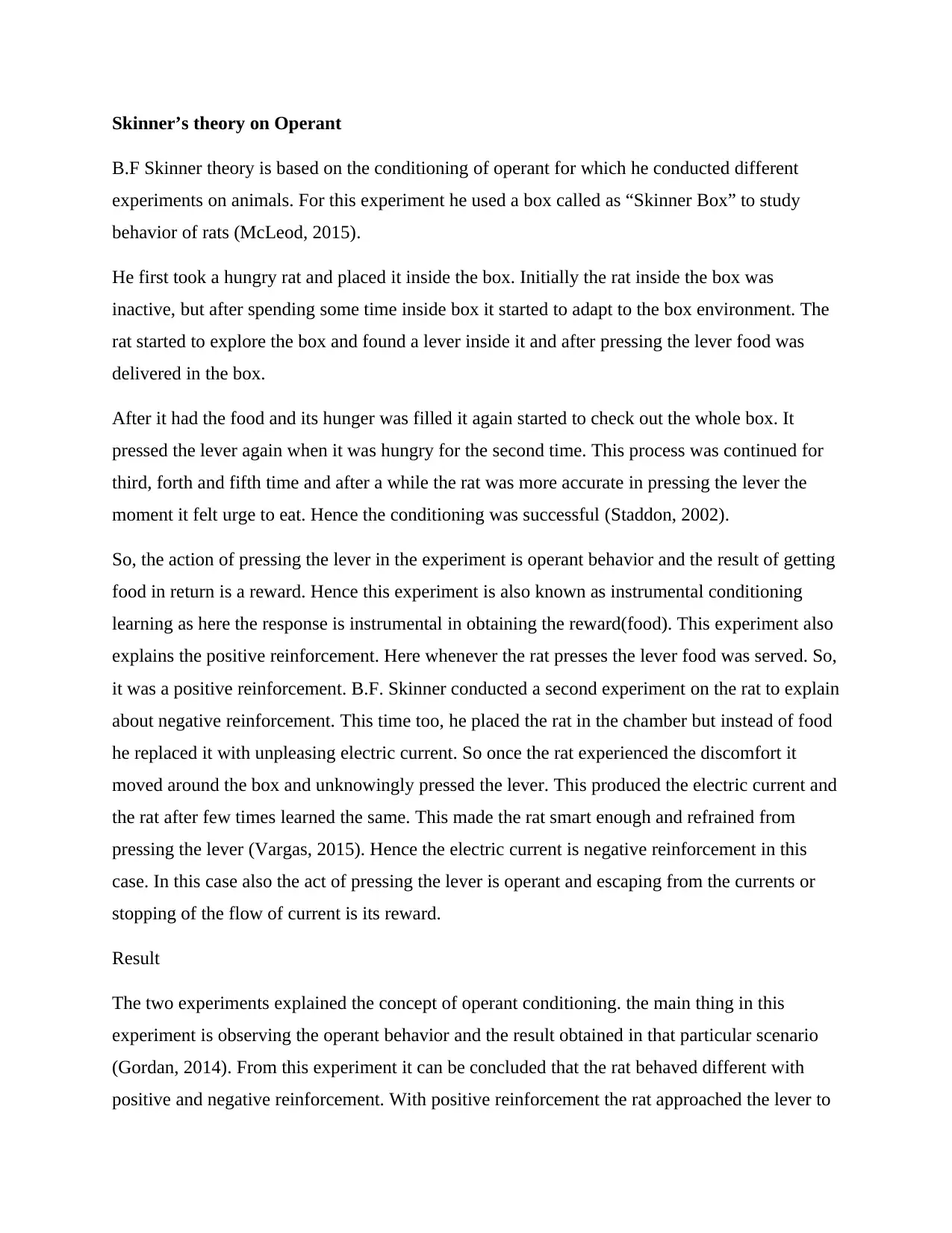
Skinner’s theory on Operant
B.F Skinner theory is based on the conditioning of operant for which he conducted different
experiments on animals. For this experiment he used a box called as “Skinner Box” to study
behavior of rats (McLeod, 2015).
He first took a hungry rat and placed it inside the box. Initially the rat inside the box was
inactive, but after spending some time inside box it started to adapt to the box environment. The
rat started to explore the box and found a lever inside it and after pressing the lever food was
delivered in the box.
After it had the food and its hunger was filled it again started to check out the whole box. It
pressed the lever again when it was hungry for the second time. This process was continued for
third, forth and fifth time and after a while the rat was more accurate in pressing the lever the
moment it felt urge to eat. Hence the conditioning was successful (Staddon, 2002).
So, the action of pressing the lever in the experiment is operant behavior and the result of getting
food in return is a reward. Hence this experiment is also known as instrumental conditioning
learning as here the response is instrumental in obtaining the reward(food). This experiment also
explains the positive reinforcement. Here whenever the rat presses the lever food was served. So,
it was a positive reinforcement. B.F. Skinner conducted a second experiment on the rat to explain
about negative reinforcement. This time too, he placed the rat in the chamber but instead of food
he replaced it with unpleasing electric current. So once the rat experienced the discomfort it
moved around the box and unknowingly pressed the lever. This produced the electric current and
the rat after few times learned the same. This made the rat smart enough and refrained from
pressing the lever (Vargas, 2015). Hence the electric current is negative reinforcement in this
case. In this case also the act of pressing the lever is operant and escaping from the currents or
stopping of the flow of current is its reward.
Result
The two experiments explained the concept of operant conditioning. the main thing in this
experiment is observing the operant behavior and the result obtained in that particular scenario
(Gordan, 2014). From this experiment it can be concluded that the rat behaved different with
positive and negative reinforcement. With positive reinforcement the rat approached the lever to
B.F Skinner theory is based on the conditioning of operant for which he conducted different
experiments on animals. For this experiment he used a box called as “Skinner Box” to study
behavior of rats (McLeod, 2015).
He first took a hungry rat and placed it inside the box. Initially the rat inside the box was
inactive, but after spending some time inside box it started to adapt to the box environment. The
rat started to explore the box and found a lever inside it and after pressing the lever food was
delivered in the box.
After it had the food and its hunger was filled it again started to check out the whole box. It
pressed the lever again when it was hungry for the second time. This process was continued for
third, forth and fifth time and after a while the rat was more accurate in pressing the lever the
moment it felt urge to eat. Hence the conditioning was successful (Staddon, 2002).
So, the action of pressing the lever in the experiment is operant behavior and the result of getting
food in return is a reward. Hence this experiment is also known as instrumental conditioning
learning as here the response is instrumental in obtaining the reward(food). This experiment also
explains the positive reinforcement. Here whenever the rat presses the lever food was served. So,
it was a positive reinforcement. B.F. Skinner conducted a second experiment on the rat to explain
about negative reinforcement. This time too, he placed the rat in the chamber but instead of food
he replaced it with unpleasing electric current. So once the rat experienced the discomfort it
moved around the box and unknowingly pressed the lever. This produced the electric current and
the rat after few times learned the same. This made the rat smart enough and refrained from
pressing the lever (Vargas, 2015). Hence the electric current is negative reinforcement in this
case. In this case also the act of pressing the lever is operant and escaping from the currents or
stopping of the flow of current is its reward.
Result
The two experiments explained the concept of operant conditioning. the main thing in this
experiment is observing the operant behavior and the result obtained in that particular scenario
(Gordan, 2014). From this experiment it can be concluded that the rat behaved different with
positive and negative reinforcement. With positive reinforcement the rat approached the lever to
⊘ This is a preview!⊘
Do you want full access?
Subscribe today to unlock all pages.

Trusted by 1+ million students worldwide
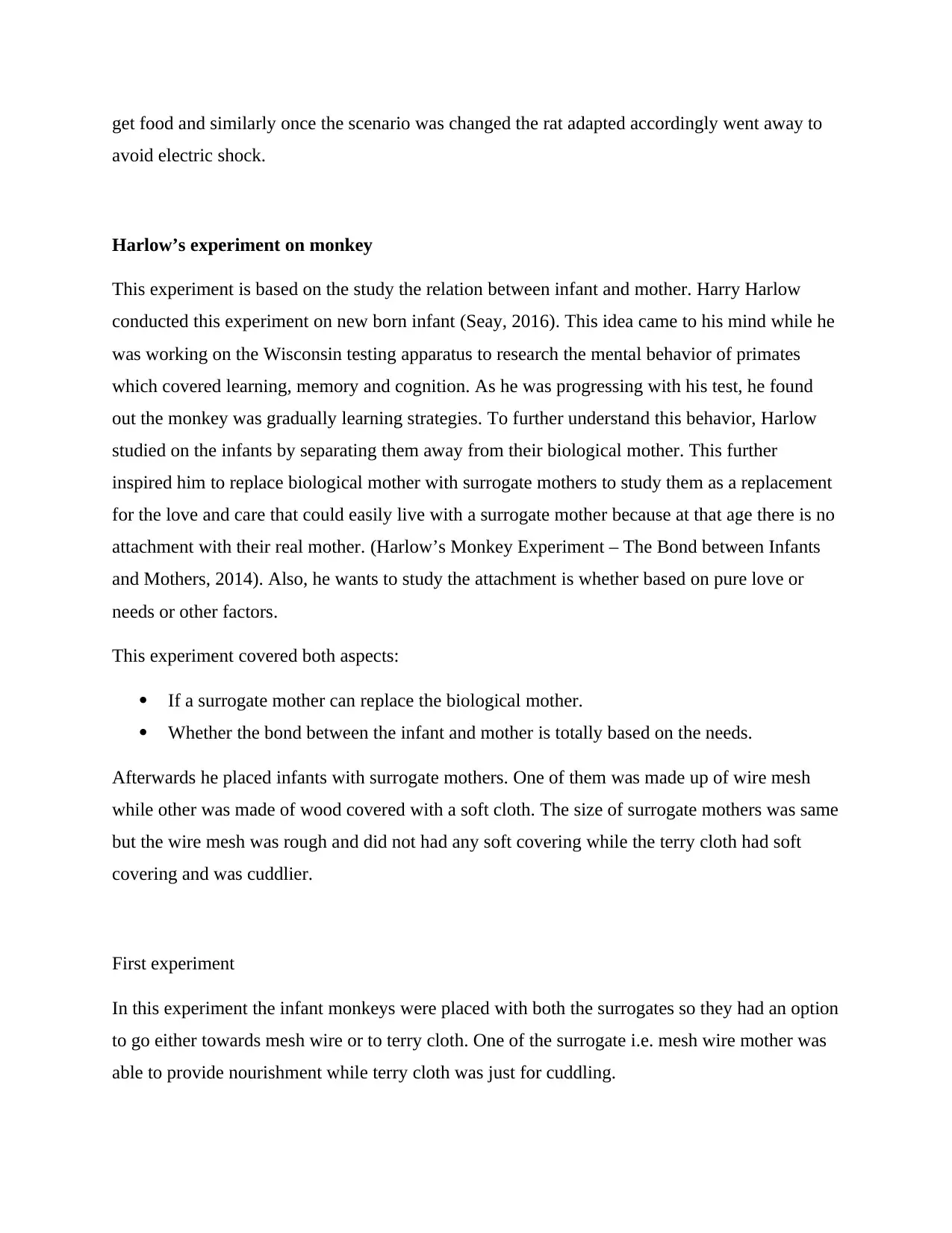
get food and similarly once the scenario was changed the rat adapted accordingly went away to
avoid electric shock.
Harlow’s experiment on monkey
This experiment is based on the study the relation between infant and mother. Harry Harlow
conducted this experiment on new born infant (Seay, 2016). This idea came to his mind while he
was working on the Wisconsin testing apparatus to research the mental behavior of primates
which covered learning, memory and cognition. As he was progressing with his test, he found
out the monkey was gradually learning strategies. To further understand this behavior, Harlow
studied on the infants by separating them away from their biological mother. This further
inspired him to replace biological mother with surrogate mothers to study them as a replacement
for the love and care that could easily live with a surrogate mother because at that age there is no
attachment with their real mother. (Harlow’s Monkey Experiment – The Bond between Infants
and Mothers, 2014). Also, he wants to study the attachment is whether based on pure love or
needs or other factors.
This experiment covered both aspects:
If a surrogate mother can replace the biological mother.
Whether the bond between the infant and mother is totally based on the needs.
Afterwards he placed infants with surrogate mothers. One of them was made up of wire mesh
while other was made of wood covered with a soft cloth. The size of surrogate mothers was same
but the wire mesh was rough and did not had any soft covering while the terry cloth had soft
covering and was cuddlier.
First experiment
In this experiment the infant monkeys were placed with both the surrogates so they had an option
to go either towards mesh wire or to terry cloth. One of the surrogate i.e. mesh wire mother was
able to provide nourishment while terry cloth was just for cuddling.
avoid electric shock.
Harlow’s experiment on monkey
This experiment is based on the study the relation between infant and mother. Harry Harlow
conducted this experiment on new born infant (Seay, 2016). This idea came to his mind while he
was working on the Wisconsin testing apparatus to research the mental behavior of primates
which covered learning, memory and cognition. As he was progressing with his test, he found
out the monkey was gradually learning strategies. To further understand this behavior, Harlow
studied on the infants by separating them away from their biological mother. This further
inspired him to replace biological mother with surrogate mothers to study them as a replacement
for the love and care that could easily live with a surrogate mother because at that age there is no
attachment with their real mother. (Harlow’s Monkey Experiment – The Bond between Infants
and Mothers, 2014). Also, he wants to study the attachment is whether based on pure love or
needs or other factors.
This experiment covered both aspects:
If a surrogate mother can replace the biological mother.
Whether the bond between the infant and mother is totally based on the needs.
Afterwards he placed infants with surrogate mothers. One of them was made up of wire mesh
while other was made of wood covered with a soft cloth. The size of surrogate mothers was same
but the wire mesh was rough and did not had any soft covering while the terry cloth had soft
covering and was cuddlier.
First experiment
In this experiment the infant monkeys were placed with both the surrogates so they had an option
to go either towards mesh wire or to terry cloth. One of the surrogate i.e. mesh wire mother was
able to provide nourishment while terry cloth was just for cuddling.
Paraphrase This Document
Need a fresh take? Get an instant paraphrase of this document with our AI Paraphraser
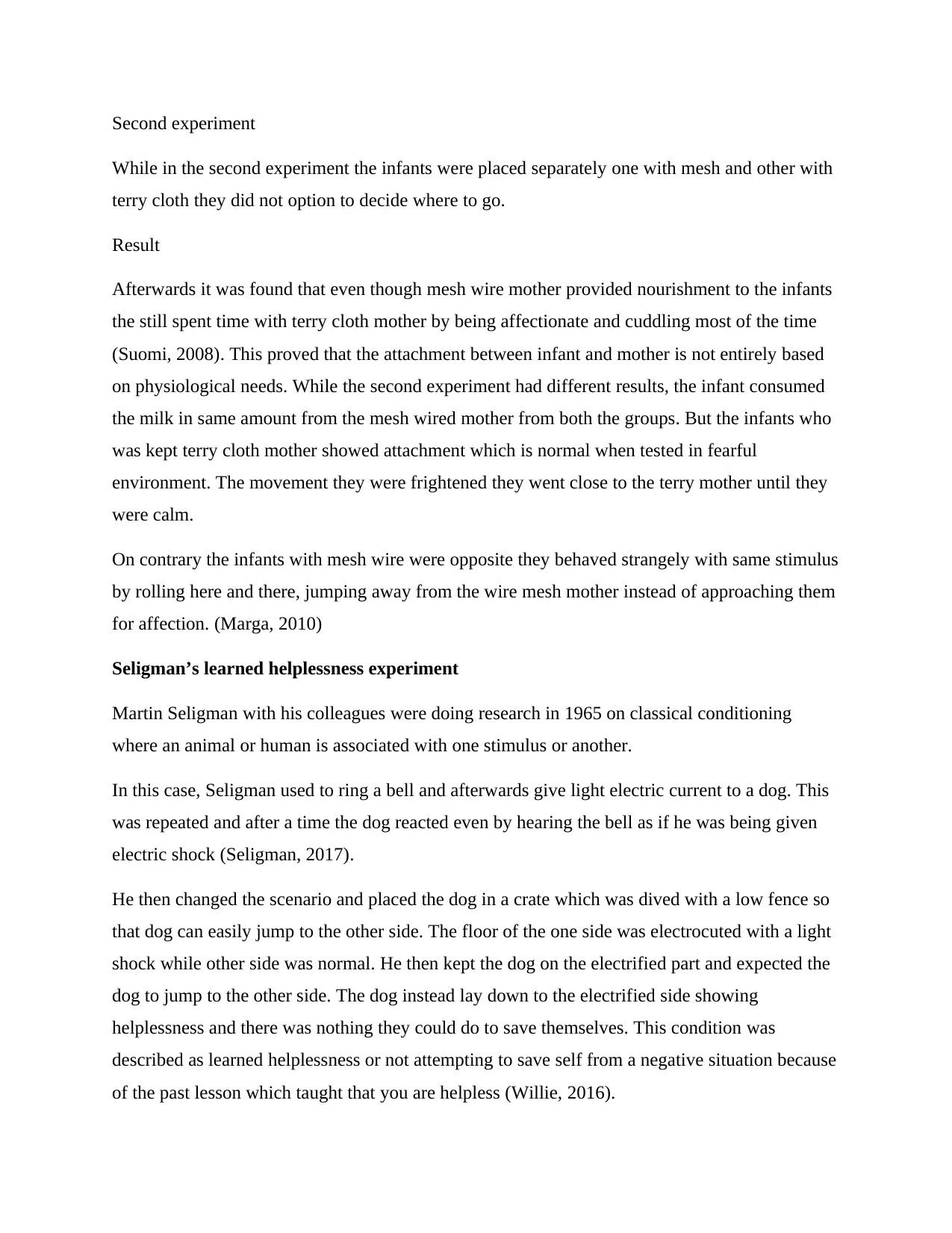
Second experiment
While in the second experiment the infants were placed separately one with mesh and other with
terry cloth they did not option to decide where to go.
Result
Afterwards it was found that even though mesh wire mother provided nourishment to the infants
the still spent time with terry cloth mother by being affectionate and cuddling most of the time
(Suomi, 2008). This proved that the attachment between infant and mother is not entirely based
on physiological needs. While the second experiment had different results, the infant consumed
the milk in same amount from the mesh wired mother from both the groups. But the infants who
was kept terry cloth mother showed attachment which is normal when tested in fearful
environment. The movement they were frightened they went close to the terry mother until they
were calm.
On contrary the infants with mesh wire were opposite they behaved strangely with same stimulus
by rolling here and there, jumping away from the wire mesh mother instead of approaching them
for affection. (Marga, 2010)
Seligman’s learned helplessness experiment
Martin Seligman with his colleagues were doing research in 1965 on classical conditioning
where an animal or human is associated with one stimulus or another.
In this case, Seligman used to ring a bell and afterwards give light electric current to a dog. This
was repeated and after a time the dog reacted even by hearing the bell as if he was being given
electric shock (Seligman, 2017).
He then changed the scenario and placed the dog in a crate which was dived with a low fence so
that dog can easily jump to the other side. The floor of the one side was electrocuted with a light
shock while other side was normal. He then kept the dog on the electrified part and expected the
dog to jump to the other side. The dog instead lay down to the electrified side showing
helplessness and there was nothing they could do to save themselves. This condition was
described as learned helplessness or not attempting to save self from a negative situation because
of the past lesson which taught that you are helpless (Willie, 2016).
While in the second experiment the infants were placed separately one with mesh and other with
terry cloth they did not option to decide where to go.
Result
Afterwards it was found that even though mesh wire mother provided nourishment to the infants
the still spent time with terry cloth mother by being affectionate and cuddling most of the time
(Suomi, 2008). This proved that the attachment between infant and mother is not entirely based
on physiological needs. While the second experiment had different results, the infant consumed
the milk in same amount from the mesh wired mother from both the groups. But the infants who
was kept terry cloth mother showed attachment which is normal when tested in fearful
environment. The movement they were frightened they went close to the terry mother until they
were calm.
On contrary the infants with mesh wire were opposite they behaved strangely with same stimulus
by rolling here and there, jumping away from the wire mesh mother instead of approaching them
for affection. (Marga, 2010)
Seligman’s learned helplessness experiment
Martin Seligman with his colleagues were doing research in 1965 on classical conditioning
where an animal or human is associated with one stimulus or another.
In this case, Seligman used to ring a bell and afterwards give light electric current to a dog. This
was repeated and after a time the dog reacted even by hearing the bell as if he was being given
electric shock (Seligman, 2017).
He then changed the scenario and placed the dog in a crate which was dived with a low fence so
that dog can easily jump to the other side. The floor of the one side was electrocuted with a light
shock while other side was normal. He then kept the dog on the electrified part and expected the
dog to jump to the other side. The dog instead lay down to the electrified side showing
helplessness and there was nothing they could do to save themselves. This condition was
described as learned helplessness or not attempting to save self from a negative situation because
of the past lesson which taught that you are helpless (Willie, 2016).
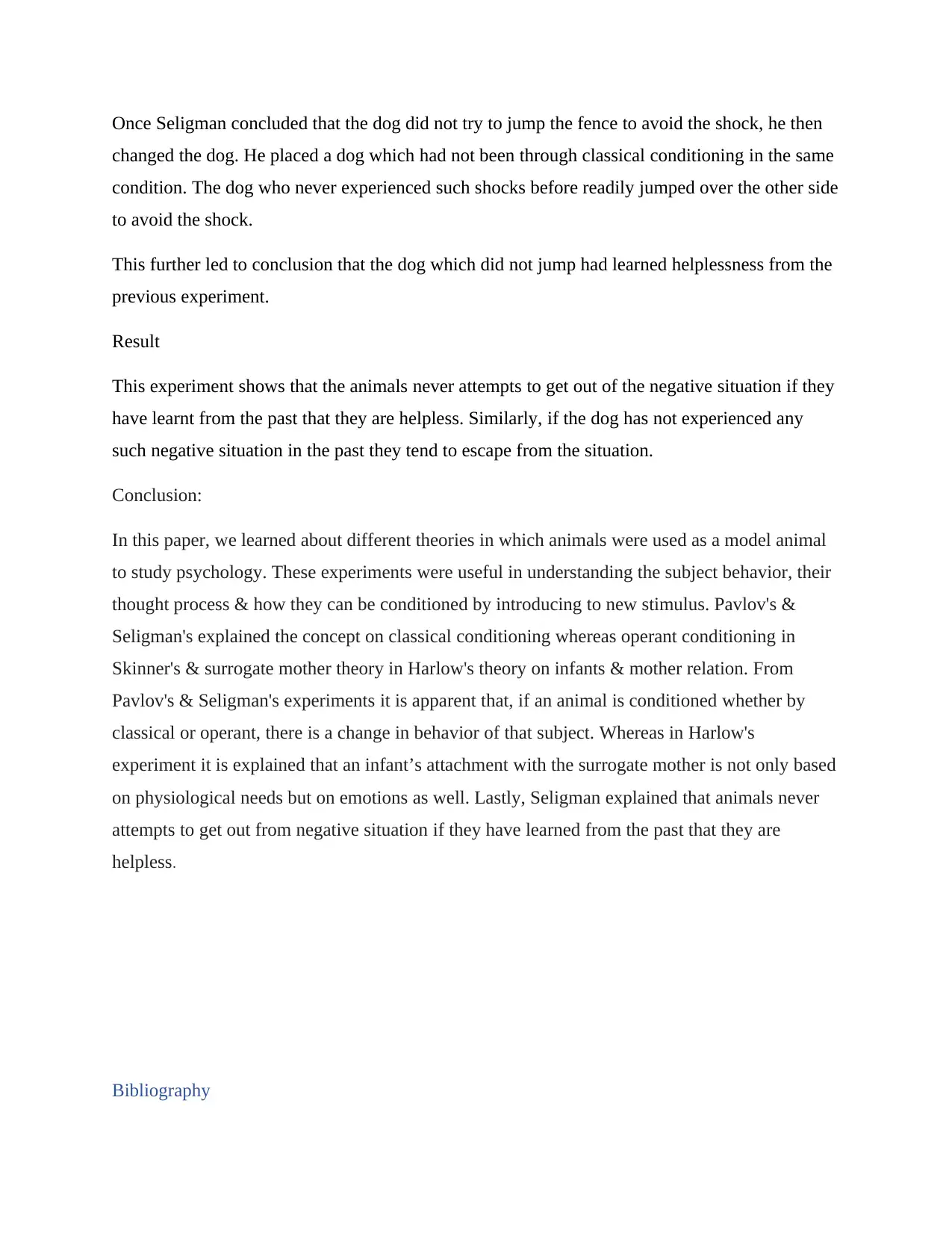
Once Seligman concluded that the dog did not try to jump the fence to avoid the shock, he then
changed the dog. He placed a dog which had not been through classical conditioning in the same
condition. The dog who never experienced such shocks before readily jumped over the other side
to avoid the shock.
This further led to conclusion that the dog which did not jump had learned helplessness from the
previous experiment.
Result
This experiment shows that the animals never attempts to get out of the negative situation if they
have learnt from the past that they are helpless. Similarly, if the dog has not experienced any
such negative situation in the past they tend to escape from the situation.
Conclusion:
In this paper, we learned about different theories in which animals were used as a model animal
to study psychology. These experiments were useful in understanding the subject behavior, their
thought process & how they can be conditioned by introducing to new stimulus. Pavlov's &
Seligman's explained the concept on classical conditioning whereas operant conditioning in
Skinner's & surrogate mother theory in Harlow's theory on infants & mother relation. From
Pavlov's & Seligman's experiments it is apparent that, if an animal is conditioned whether by
classical or operant, there is a change in behavior of that subject. Whereas in Harlow's
experiment it is explained that an infant’s attachment with the surrogate mother is not only based
on physiological needs but on emotions as well. Lastly, Seligman explained that animals never
attempts to get out from negative situation if they have learned from the past that they are
helpless.
Bibliography
changed the dog. He placed a dog which had not been through classical conditioning in the same
condition. The dog who never experienced such shocks before readily jumped over the other side
to avoid the shock.
This further led to conclusion that the dog which did not jump had learned helplessness from the
previous experiment.
Result
This experiment shows that the animals never attempts to get out of the negative situation if they
have learnt from the past that they are helpless. Similarly, if the dog has not experienced any
such negative situation in the past they tend to escape from the situation.
Conclusion:
In this paper, we learned about different theories in which animals were used as a model animal
to study psychology. These experiments were useful in understanding the subject behavior, their
thought process & how they can be conditioned by introducing to new stimulus. Pavlov's &
Seligman's explained the concept on classical conditioning whereas operant conditioning in
Skinner's & surrogate mother theory in Harlow's theory on infants & mother relation. From
Pavlov's & Seligman's experiments it is apparent that, if an animal is conditioned whether by
classical or operant, there is a change in behavior of that subject. Whereas in Harlow's
experiment it is explained that an infant’s attachment with the surrogate mother is not only based
on physiological needs but on emotions as well. Lastly, Seligman explained that animals never
attempts to get out from negative situation if they have learned from the past that they are
helpless.
Bibliography
⊘ This is a preview!⊘
Do you want full access?
Subscribe today to unlock all pages.

Trusted by 1+ million students worldwide
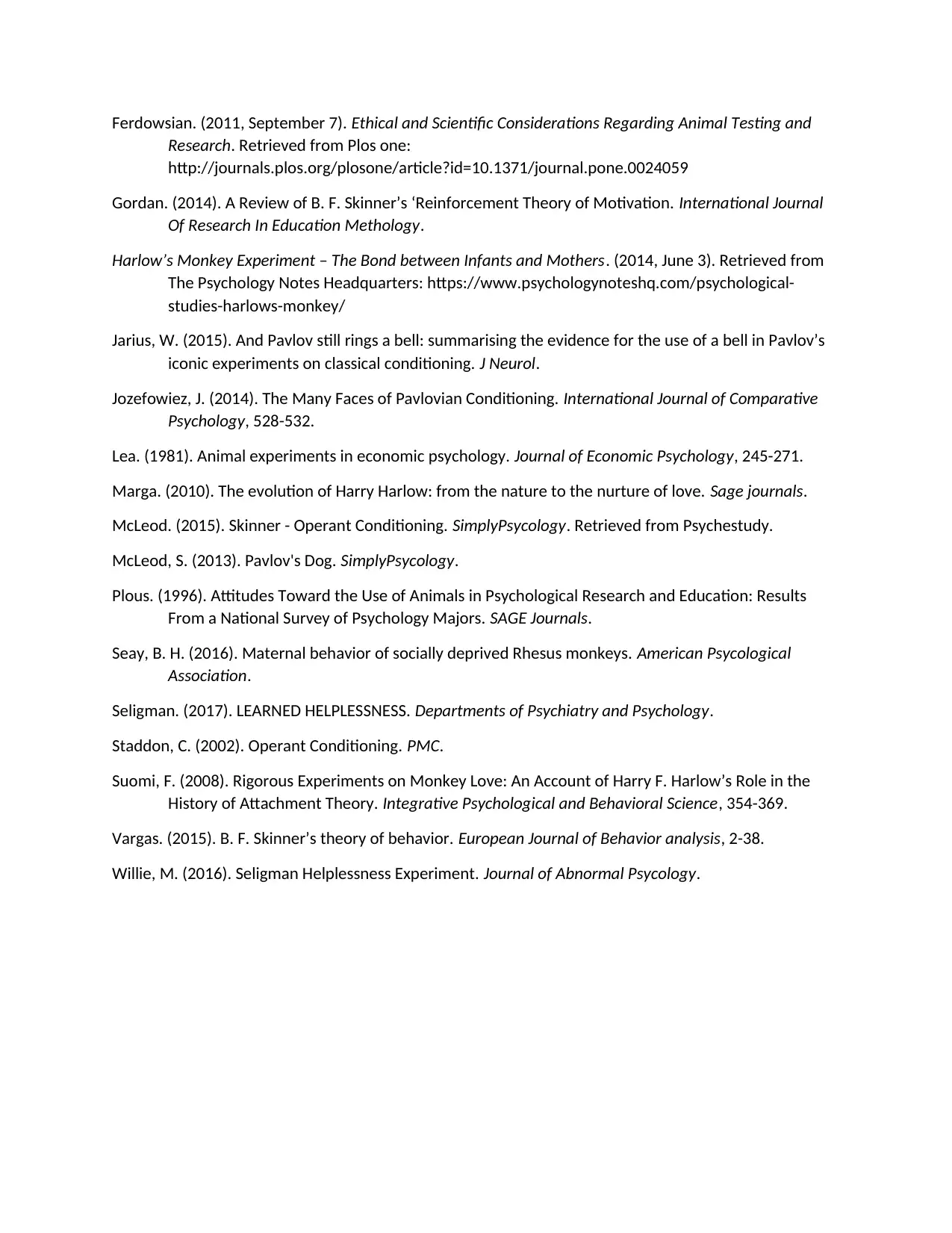
Ferdowsian. (2011, September 7). Ethical and Scientific Considerations Regarding Animal Testing and
Research. Retrieved from Plos one:
http://journals.plos.org/plosone/article?id=10.1371/journal.pone.0024059
Gordan. (2014). A Review of B. F. Skinner’s ‘Reinforcement Theory of Motivation. International Journal
Of Research In Education Methology.
Harlow’s Monkey Experiment – The Bond between Infants and Mothers. (2014, June 3). Retrieved from
The Psychology Notes Headquarters: https://www.psychologynoteshq.com/psychological-
studies-harlows-monkey/
Jarius, W. (2015). And Pavlov still rings a bell: summarising the evidence for the use of a bell in Pavlov’s
iconic experiments on classical conditioning. J Neurol.
Jozefowiez, J. (2014). The Many Faces of Pavlovian Conditioning. International Journal of Comparative
Psychology, 528-532.
Lea. (1981). Animal experiments in economic psychology. Journal of Economic Psychology, 245-271.
Marga. (2010). The evolution of Harry Harlow: from the nature to the nurture of love. Sage journals.
McLeod. (2015). Skinner - Operant Conditioning. SimplyPsycology. Retrieved from Psychestudy.
McLeod, S. (2013). Pavlov's Dog. SimplyPsycology.
Plous. (1996). Attitudes Toward the Use of Animals in Psychological Research and Education: Results
From a National Survey of Psychology Majors. SAGE Journals.
Seay, B. H. (2016). Maternal behavior of socially deprived Rhesus monkeys. American Psycological
Association.
Seligman. (2017). LEARNED HELPLESSNESS. Departments of Psychiatry and Psychology.
Staddon, C. (2002). Operant Conditioning. PMC.
Suomi, F. (2008). Rigorous Experiments on Monkey Love: An Account of Harry F. Harlow’s Role in the
History of Attachment Theory. Integrative Psychological and Behavioral Science, 354-369.
Vargas. (2015). B. F. Skinner’s theory of behavior. European Journal of Behavior analysis, 2-38.
Willie, M. (2016). Seligman Helplessness Experiment. Journal of Abnormal Psycology.
Research. Retrieved from Plos one:
http://journals.plos.org/plosone/article?id=10.1371/journal.pone.0024059
Gordan. (2014). A Review of B. F. Skinner’s ‘Reinforcement Theory of Motivation. International Journal
Of Research In Education Methology.
Harlow’s Monkey Experiment – The Bond between Infants and Mothers. (2014, June 3). Retrieved from
The Psychology Notes Headquarters: https://www.psychologynoteshq.com/psychological-
studies-harlows-monkey/
Jarius, W. (2015). And Pavlov still rings a bell: summarising the evidence for the use of a bell in Pavlov’s
iconic experiments on classical conditioning. J Neurol.
Jozefowiez, J. (2014). The Many Faces of Pavlovian Conditioning. International Journal of Comparative
Psychology, 528-532.
Lea. (1981). Animal experiments in economic psychology. Journal of Economic Psychology, 245-271.
Marga. (2010). The evolution of Harry Harlow: from the nature to the nurture of love. Sage journals.
McLeod. (2015). Skinner - Operant Conditioning. SimplyPsycology. Retrieved from Psychestudy.
McLeod, S. (2013). Pavlov's Dog. SimplyPsycology.
Plous. (1996). Attitudes Toward the Use of Animals in Psychological Research and Education: Results
From a National Survey of Psychology Majors. SAGE Journals.
Seay, B. H. (2016). Maternal behavior of socially deprived Rhesus monkeys. American Psycological
Association.
Seligman. (2017). LEARNED HELPLESSNESS. Departments of Psychiatry and Psychology.
Staddon, C. (2002). Operant Conditioning. PMC.
Suomi, F. (2008). Rigorous Experiments on Monkey Love: An Account of Harry F. Harlow’s Role in the
History of Attachment Theory. Integrative Psychological and Behavioral Science, 354-369.
Vargas. (2015). B. F. Skinner’s theory of behavior. European Journal of Behavior analysis, 2-38.
Willie, M. (2016). Seligman Helplessness Experiment. Journal of Abnormal Psycology.
1 out of 7
Related Documents
Your All-in-One AI-Powered Toolkit for Academic Success.
+13062052269
info@desklib.com
Available 24*7 on WhatsApp / Email
![[object Object]](/_next/static/media/star-bottom.7253800d.svg)
Unlock your academic potential
Copyright © 2020–2025 A2Z Services. All Rights Reserved. Developed and managed by ZUCOL.





